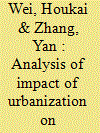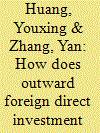|
|
|
Sort Order |
|
|
|
Items / Page
|
|
|
|
|
|
|
| Srl | Item |
| 1 |
ID:
152520


|
|
|
|
|
| Summary/Abstract |
As a developing country with great regional disparities, China's rapid urbanization has had important impacts on environmental quality. In this study, the drivers-mechanisms-effects (DME) model is built, which shows how element agglomeration, scale growth, knowledge accumulation and industry evolution drive the environmental system to change during the urbanization process. An econometric regression model using provincial panel data is further constructed to empirically analyze the impacts of urbanization on environmental quality. It is shown that during the process of urbanization in China, element agglomeration and knowledge accumulation help to improve environmental quality but with weak positive effect, while growing urban scale and industrial structure have obvious negative effects on environmental quality. The “inverted-U shape” (up first and then down) change in the environmental quality during China's urbanization process is obvious. It is critical that China concentrates on the transformations of both city development paths and urbanization models to reduce resource and environmental costs as much as possible.
|
|
|
|
|
|
|
|
|
|
|
|
|
|
|
|
| 2 |
ID:
115697


|
|
|
|
|
| Publication |
2012.
|
| Summary/Abstract |
Using a center of gravity model and GIS software, we measured how China's energy production and consumption centers changed (positions, movements, distances, and rates) from 1997 to 2009, thereby revealing regional differences in the relationship between supply and demand. We found that the centers of gravity for raw coal consumption, crude oil production and consumption, and electricity production and consumption moved southwest during the study period, whereas those of raw coal and natural gas production moved northwest and that of natural gas consumption moved southeast. The distances moved were largest for natural gas, followed by crude oil, but the distances were small for raw coal and electricity, indicating that their supply and demand pattern changed little during the study period. The gaps between supply and demand for raw coal, crude oil, and natural gas were large, and tended to increase. The production centers were northwest of the consumption centers, indicating that China's energy production is concentrated in the northwest, whereas consumption was concentrated in the southeast. This pattern resulted from the distribution of China's energy resource reserves and its energy development strategies. Recommendations are provided to reduce the gap between supply and demand.
|
|
|
|
|
|
|
|
|
|
|
|
|
|
|
|
| 3 |
ID:
158908


|
|
|
|
|
| Summary/Abstract |
In the post‐reform era, China achieved poverty reduction that was unprecedented in human history This poverty reduction was accompanied by fast growth and worsening income distribution. The present paper examines the poverty–growth–inequality triangle in China by: (i) providing growth, inequality and poverty profiles at the national and provincial levels; (ii) uncovering the contributions of growth and inequality changes to poverty reduction; and, finally, (iii) drawing lessons for other developing countries. Based on the World Bank's definition of the poverty line, China has already eliminated abject poverty, even though the poverty rate was as high as 88.3 percent in 1981. The remarkable record in poverty reduction is predominantly attributable to growth. The effect of inequality varied in different periods. In addition, the impact of growth on poverty reduction is found to be diminishing over time, a phenomenon worth further research and policy attention.
|
|
|
|
|
|
|
|
|
|
|
|
|
|
|
|
| 4 |
ID:
159043


|
|
|
|
|
| Summary/Abstract |
Using an original linked firm-level panel data from Chinese manufacturing firms over the period 2002–2007, this paper examines how outward foreign direct investment (OFDI) led productivity increase of parent firms (known as the own-firm effect) changes over firm heterogeneity. Conducting propensity score matching (PSM) techniques and differences-in-differences (DID) analysis, we find strong and robust evidence that the first OFDI promotes parent firm's productivity and this effect varies substantially with the firms' characteristics. In particular, firm's absorptive capacity is essential for the own-firm effect, and the absorptive capacity related with the product innovation is more important than that of the process innovation for the own-firm effect. Also, OFDI strategies for obtaining advanced technology and investing in developed countries significantly strengthen the own-firm effect, whereas, government supports have no significant impacts on the own-firm effect.
|
|
|
|
|
|
|
|
|
|
|
|
|
|
|
|
| 5 |
ID:
190457


|
|
|
|
|
| Summary/Abstract |
Governance is essentially a dynamic mechanism to promote collective action for the common good. The Chinese concept of the public/common (gōnggòng) and its political philosophy of Grand Union governance provide an alternative perspective for understanding such dynamics from the unit of family through institutions to the state-embedded society. Three critical arguments with interconnected elements are analysed: governance as a dynamic mechanism; review of the historical, philosophical and political legacy of Chinese governance; and proposal of a framework for governance of the Grand Union. It concludes that ‘Chinese characteristics’, such as diverse adaptations, gradual flexibility, experimental pragmatism, and polycentric balance with a strong central state are all deeply rooted in its pre-revolutionary ancien régime. In order to understand these seemingly different institutions and values, we need to revisit their original functionality of governing for the common good.
|
|
|
|
|
|
|
|
|
|
|
|
|
|
|
|
| 6 |
ID:
156440


|
|
|
|
|
| Summary/Abstract |
Our paper investigates the relationship between financial stability and mortgage lending. We estimated the effect of the share of mortgage lending by individual banks (together with some control variables) on two measures of financial stability—the bank Z-score and the non-performing loan ratio—for a sample of 1889 banks in 65 advanced and emerging economies for the period 1987–2014 from the Bankscope database. We specifically compared the behavior of banks in Europe and Asia. We find evidence that an increased share of mortgage lending is positive for financial stability, specifically by lowering the probability of default by financial institutions and reducing the non-performing loan ratio, at least in non-crisis periods, for levels of mortgage shares up to 49–68%. For higher levels of mortgage lending shares, the impact on financial stability turns negative. Also, the occurrence of a banking crisis reduces the diversification benefits associated with mortgage lending. Compared with the base sample, Asian banks show greater financial stability during non-crisis periods, but are more negatively affected by a higher mortgage ratio during crisis periods, while European banks show greater financial stability during non-crisis periods, but are less negatively affected during crisis periods. Finally, a higher level of regulatory quality improves both financial stability measures, but the effects of macroprudential measures are found to be mixed.
|
|
|
|
|
|
|
|
|
|
|
|
|
|
|
|
| 7 |
ID:
110712


|
|
|
|
|
| Publication |
2011.
|
| Summary/Abstract |
Energy-related carbon emissions in China have increased significantly. To mitigate these emissions, it is necessary to estimate the trends (increase or decrease) and the magnitudes of the influences (tons of carbon emitted) as a result of four causal factors that affect emissions: GDP, economic structure, energy intensity, and fuel mix. To do so, we have divided the study period into three intervals (from 1995 to 2009) based on China's three most-recent 5-year plans. We then divided China's 30 provinces into four categories based on the individual and net effects of these factors on carbon emissions. On this basis, we discuss potential strategies for reducing China's carbon emissions. Increasing GDP caused the largest increase in carbon emissions, whereas decreasing energy intensity significantly decreased emissions. Changes in the economic structure increased emissions, with the economic structure becoming more carbon-intensive; efforts to optimize the fuel mix slightly decreased emissions during the first and third periods, but increased emissions during the second period. Our analysis also revealed differences between provinces and regions, allowing local managers to focus on the most important problems for their area. To reduce future energy-related carbon emissions, China's economic structure, energy intensity, and fuel mix must all be improved.
|
|
|
|
|
|
|
|
|
|
|
|
|
|
|
|
| 8 |
ID:
143399


|
|
|
|
|
| Summary/Abstract |
This paper studies the effects of sex imbalance on matching patterns in China's marriage markets. We hypothesize that the economic inequality caused by economic liberalization, together with sex imbalance, will lead to women's hypergamy (marrying up). Employing CGSS data, our empirical findings support the hypothesis. We also establish that sex imbalance enhances the postnuptial bargaining power of the wife vis-à-vis the husband in intra-household resource allocation. The findings are robust to IV estimation and robustness checks.
|
|
|
|
|
|
|
|
|
|
|
|
|
|
|
|
|
|
|
|
|